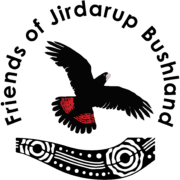By Oscar Garswood, April 2022.
Jirdarup Bushland has a large amount of native biodiversity in comparison to the surrounding suburb, highlighting the importance to native wildlife. A caveat is that these species may be affected by diseases. One of these diseases that is prominent in the bushland is Witches’ Broom. (Image: Vicki Caulfield. Garden glove for scale.)
Witches’ Broom is a condition that is sometimes caused by pathogens in woody plants and trees. The pathogen results in a deformity of the tree, that resembles a bird’s nest or a broom, hence the name Witches’ Broom. 1 Organisms such as fungi called basidiomycetes or phytoplasma bacteria can cause this condition. 2,3 Many Banksias in Jirdarup have this condition, however the specific organism causing it is unknown. 2
Witches’ Broom is a natural phenomenon. If it proves to be an issue, removing the affected branch may be an effective way to treat it. In our bushland it’s part of the ecosystem and the insects and birds have rich interactions with it.
4Tilley, N. (2020). Signs and Symptoms of Witches’ Broom on Trees and Shrubs
Prepared by Oscar Garswood, April 2022.



